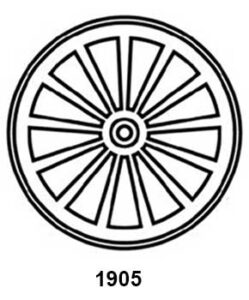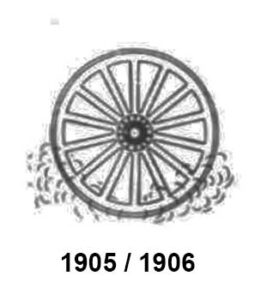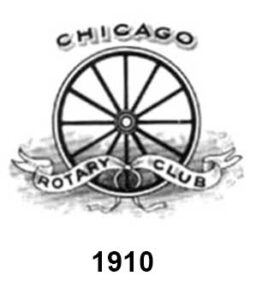Rotary History Wheel Logo 1905 - Date - Las Vegas WON Rotary
The Many Versions of the Rotary Wheel Logo
As with anything in life, as an organization grows many things change over time. The Rotary Wheel logo is a perfect example of how many versions have occurred over the years from emblems to the worldwide approved wheel logo version used today. Listed below are the major variations of the Rotary wheel from 1905 to date. The explanations and photos below will give you a full history of how the Rotary wheel has developed.


1905 Rotary Wheel
In the beginning, 1905, Paul Harris and the Rotary Club of Chicago members agreed a wheel should be the emblem of Rotary.
Harry Ruggles, known as the “Fifth Rotarian” owned a print company and he selected a buggy wheel as the emblem showing a bold circle with a hub of spokes.
This rough first version of the Rotary emblem / logo gives the credits to Ruggles for making the first print version of the wheel.

1905 Rotary Wheel
In 1905/6, many members thought the plain wheel needed to be better.
An engraver, Montaque M. Bear, who was a member of the Rotary Club of Chicago, he made the next version where he added some clouds at the bottom of the 13-spoke wheel and the words Rotary Club added above the wheel.
Once again, members were not overly impressed as they thought the clouds added to the bottom around the wheel really looks like dust, even though dust would defy the laws of physics by being on both sides of the wheel.
1906 Rotary Wheel
Back to the drawing board and another new version in 1906 was created.
This 1906 version featured with the words “Rotary Club“ placed over the wheel was first time the wheel and the word Rotary meet in a design.


1910 Rotary Wheel
In 1910, the 13-spoke wagon wheel had heavily influenced other clubs and Rotary.
There were 16 Rotary clubs and each had their own Rotary wheel design in 1910.
During the first Rotary convention in Chicago in 1910, the National Association of Rotary Clubs was created.
The National Association decided to place the word “Chicago” above the wheel.

1912 Rotary Wheel
With various new clubs each creating their own versions of the Rotary wheel emblems, in 1911, Secretary Chesley R. Perry recommended a standard emblem be used by every Rotary club. The existing Rotary clubs were invited to submit their designs to a newly formed emblem committee before the 1912 Duluth convention.
The Duluth 1912 convention was the true beginning of making a basic design principle of a wheel with gears on the outer edge. These suggested the word “Rotary” be placed at the top and the words “International Association” be at the bottom. This change was heavily influenced because Rotary became an international organization in 1912. Clubs were urged to use a similar design and replace the International Association with the name of their city at the bottom. Still, no specifics were given for the number of spokes or cogs to be used which caused many variations throughout the clubs.
The 1912 wheel version was a gear wheel with royal blue and gold colors. Once again many did not like this version as they said the gear wheel look mechanically unsound. Oscar B. Bjoge, of the Rotary Club of Duluth, and Charles Henry Mackintosk, of the Rotary Club of Chicago, were added to the committee with the purpose of standardizing the Rotary emblem.

1924 Rotary Wheel
In 1919, Bjorge version of the emblem had 8 spokes and 24 cogs on the outer rim. He felt this gave a sturdy appearance. The objective of his design was to make a real-looking gear wheel. The overall numbers or ratios of spokes and cogs have no related value to anything in Rotary.
In late November 1919, the Board accepted Bjorge design.
In 1920, there were 57 different emblems being used nationally. Obviously, uniformity is good and something needed to be done to make Rotary a smooth-looking organization.
In 1921 at the annual convention in Edinburgh, Scotland, they formally approved the Bjorge design.
In 1924, the Rotary International Board approved a revised version of Bjorge design. The fix of adding the keyway has been attributed to Will R. Forker, of the Rotary Club of Los Angeles. This revised version demonstrated the gear was capable of transmitting power to a shaft. The new version of the logo with a keyway satisfied everyone and this has been the designed used to present time.
However, communication and the ability to clear up any non-uniformity of the Rotary Wheel’s newest version were difficult in the 1920s. It was formally approved with the keyway version until the 1929 convention in Dallas, Texas.

Interesting Wheel Facts
For approximately 100 years the Rotary Wheel appearance has not changed. As time passed the word Rotary has been placed next to the wheel for more clarity and ease of reading.
But, the wheel itself did not change, only the word ”Rotary” was placed in large letters on the left side of the gear wheel, thus giving us the version we use today.
For many decades, Rotary has been extremely specific about the color of the logo, font usage, etc. They do not allow you to change the font and in color images it must be the Rotary colors.



